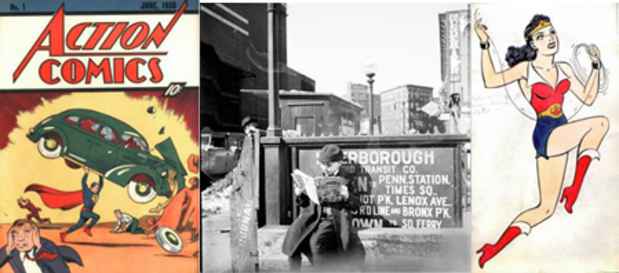“Superheroes in Gotham” Exhibition
The New-York Historical Society

This event has ended.
This fall, the New-York Historical Society will share the untold history of comic books, a cultural phenomenon born in 1930s New York City that has since taken the world by storm. Superheroes in Gotham will focus on our culture’s most legendary superheroes – Superman, Batman, Wonder Woman, Captain America, Spider-Man and Iron Man – as well as more recent characters inspired by the contemporary city. Beyond the characters, Superheroes in Gotham will consider the importance of New York as a creative force behind a uniquely American mythology.
Among the range of material on display will be a rare comic book featuring Superman’s first appearance (Action Comics No. 1, June 1938), clips from early radio and film adaptations, Philip Pearlstein’s Superman painting (1952), original drawings by Steve Ditko of Spider-Man’s first appearance in Amazing Fantasy (No. 15, 1962), a Batmobile made for the Batman television series (1966), a costume from Broadway’s Spider-Man: Turn off the Dark (2011), and hip-hop pioneer Darryl McDaniels’ DMC comic book (2014) and his signature fedora.
“Comics are a huge cultural force, but few remember their New York roots,” said Dr. Louise Mirrer, President and CEO of the New-York Historical Society. “Superheroes in Gotham will immerse visitors in the early days of comics and their evolution, so they can learn more about the genesis of their favorite characters, encounter new voices that continue the creative tradition today, and perhaps see aspects of their own neighborhoods imaginatively captured on the page.”
The exhibition is curated by the New-York Historical Society’s Debra Schmidt Bach, Associate Curator of Decorative Arts, and Nina Nazionale, Director of Library Operations.
Exhibition Overview
Upon entering the New-York Historical Society’s Central Park West entrance, visitors will be greeted by an original working Batmobile (1966), one of three cars created for the 1966-68 Batman television series. The first gallery will trace each character’s origins within the context of their creators and period events. A range of first-issue comic books will be displayed, including Superman’s Action Comics No. 1 (June 1938) and Batman No. 1 (Spring 1940). During World War II, many superhero stories channeled American concerns about the conflict and several of their creators also enlisted. Wartime issues of Captain America (1942) and an original drawing (ca. 2000) by Joe Simon—who served in the U.S. Coast Guard— will present Captain America as the ultimate patriotic warrior. Superman was also enlisted and lent his support in a range of U.S. Army and Navy training materials (ca. 1942-43). A drawing of Wonder Woman in an early version of her patriotic costume by H.G. Peter (ca. 1941) will be shown alongside a “Wonder Woman for President” issue (No. 7, Winter 1943).
Two of Steve Ditko’s original drawings of Spider-Man’s first appearance in Amazing Fantasy (No. 15, September 1962) will be displayed alongside a copy of the published issue. Considered Spider-Man’s “birth certificate,” these drawings will be on public view for the first time outside of the Library of Congress. Other Cold War-era artifacts include original cover art for The Invincible Iron Man (No. 1, 1968).
The second gallery will explore how superheroes flew from page to screen decades before they became blockbuster movie franchises. Scripts, audio recordings, animation cels, and cartoon clips will illuminate Superman’s multimedia adaptation less than two years after his comic book debut. One particular clip from the Superman cartoon (1941) will depict the character flying for the first time, rather than leaping as he did in print. After appearing in two film serials in the 1940s, Batman was reimagined in a popular television series (1966-68) and full length film (released in 1966). In addition to the original Batmobile (1966), the exhibition will feature three Batman set paintings by art director Leslie Thomas (ca. 1966-68) and a Catwoman costume (ca. 1966). Clips from the Wonder Woman television series (1975-79), as well as a copy of Ms. magazine’s first issue depicting her at the helm (1972), illuminate Wonder Woman’s development as a second-wave feminist icon.
The final gallery will examine the enduring influence of superheroes on a wide range of New York-based artists, cartoonists, contemporary comic book creators, and fans. Known today for his hyperreal nude portraits, the exhibition will feature Philip Pearlstein’s Superman (1952), a proto-Pop art painting from his early career. Also featured will be cartoonist Mort Gerberg’s original illustration art for The New Yorker (“Do you have any references besides Batman?,” July 1997), alongside Batman drawings he doodled inside a childhood Hebrew School book (circa 1940). A costume from Spider-Man: Turn off the Dark (2011), the most expensive production in Broadway history, will also be exhibited.
Superheroes in Gotham also will explore contemporary New York- based superhero comics. A copy of DMC (2014)—which follows the comic book alter-ego of musician Darryl McDaniels of Run-DMC in 1980s New York—will be displayed alongside the hip-hop pioneer’s trademark fedora, glasses and Adidas sneakers (worn by the fictional superhero DMC as well). Also on view will be art from Dean Haspiel’s independent web-based comic books, including the Brooklyn-based Red Hook and a comic book set, in part, during the 2003 blackout. The exhibition will conclude with ephemera from the United States’ first comic convention, which took place in New York in 1964, as well as photographs and posters from recent years of Comic Con.
Media
Schedule
from October 09, 2015 to February 21, 2016